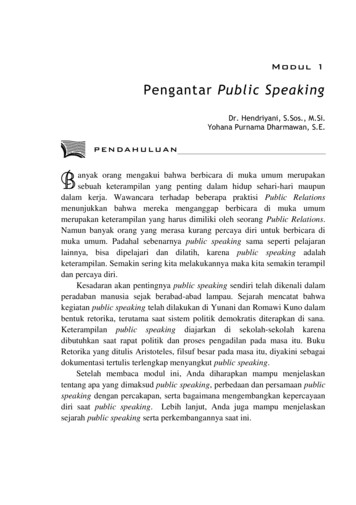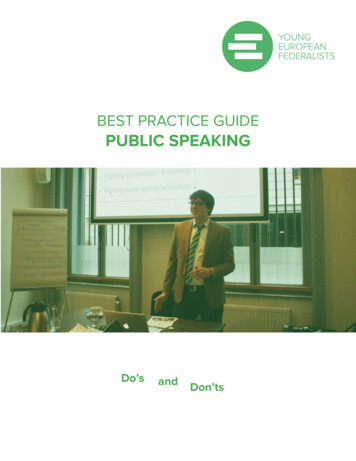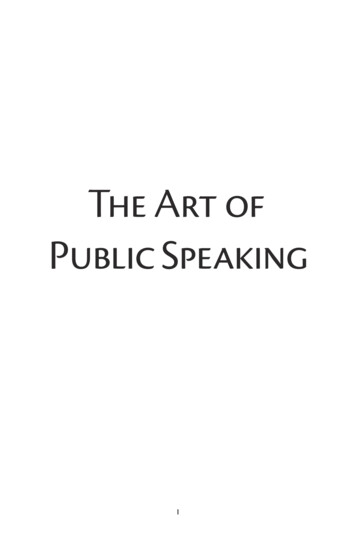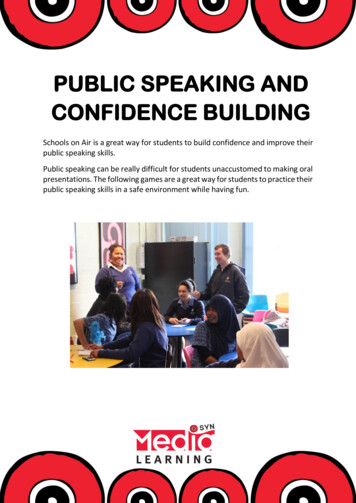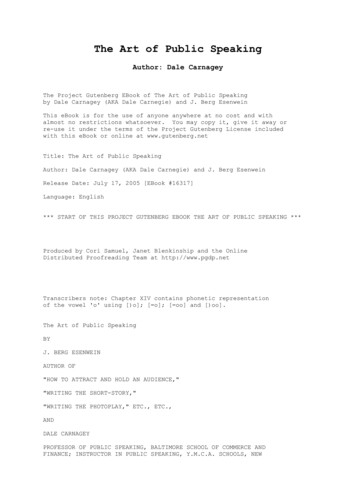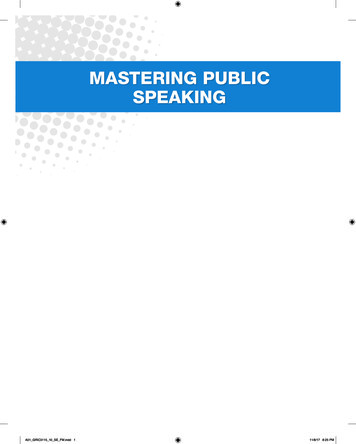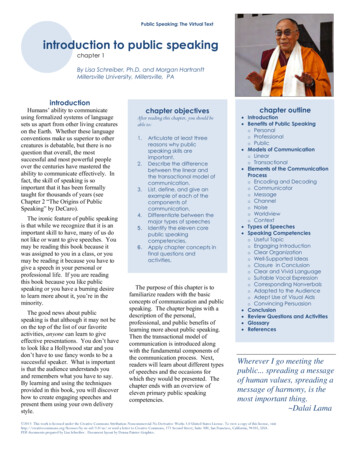
Transcription
MASTER’S PROGRAMCurricula for M.Ed.ENG063 TEXT ANALYSIS AND RESEARCH ESSAY PROGRAMThis is required reading for all M.Ed. students. Read through the reports andhighlight key points in yellow as you analyze the strategies of teaching.(Alternatively, you can copy the key points and paste them into a separatefile.) Draw on the findings of applied neuroscience and reflect on how this canbe projected into a classroom or teaching/learning setting. After reading eachthesis and highlighting key points, send the highlighted thesis (or separate filewith the points you gathered) to your tutor by email. Additionally, you willneed to write an 80-page (double space, size 12 font) thesis using the keypoints that support the theme of your thesis.Note: ENG063 reflects personal quality thinking and excellent researchskills; this serves as a foundation course before you complete your 80-pageanalytical thesis. Your thesis will be evaluated and graded by an assigneduniversity mentor.THE ART OF PUBLIC SPEAKINGAuthor – Prof. Cindy H. Robertson
2.PREFACE2.1SUBJECT OF INVESTIGATION:Academic lecture methodology. In particular, techniques to improve oral disseminationof knowledge when speaking publicly and in the classroom for better audience andstudent retention.Needs, Interests and Problems DetectedThe speech or lecture is one of the most direct methods for conveying knowledgepublicly and in the classroom, but unfortunately it is often the most boring and ineffectualas well. Students and audiences tune out and vital information remains unabsorbed.Speeches do not have to be dry and dull, however. Teachers and professors can employtested techniques to energize their public speaking and invigorate lectures so audiencesand students alike will take notice and benefit.2.2JUSTIFICATION OF THE THESIS THEME:Most teaching professionals are called upon to give speeches and also to spend at leastpart of their classroom time disseminating course material by means of lectures.However, the oral transmission of knowledge is effective only if it is received by thelistener, and sadly it is no secret that the majority of speakers fail to keep the attention oftheir audience. Their presentations are often dry, rambling and dull. Nevertheless,problems of listener boredom and retention failure can be greatly ameliorated if academicprofessionals learn to apply the powerful and persuasive speaking techniques used byskilled, successful public speakers. This thesis distills the most effective of these methodsfor instructors to apply to their individual teaching styles.2
3.OBJECTIVESThe objective of this thesis is to empower educators to improve the quality of theirlectures with the application of proven public-speaking techniques.3.1GENERAL INFORMATIONEducators are often called upon to give speeches and presentations and much of theinformation they teach their students is presented in the lecture format. However, intoday’s world of fast-paced entertainment and commercial messages, audiences,including students, are no longer accustomed to sitting and listening to someone talk foran extended length of time. Speeches delivered in a dry, lifeless manner cause audiencesto become bored and their thoughts to wander to other concerns. In contrast, wheneducators employ effective speaking techniques in their lectures, they can capture theminds and even the hearts of their audiences with presentations not soon forgotten.3.2SPECIFICATIONSThis thesis will examine the most effective communication techniques used by publicspeaking experts and demonstrate how to apply them in academic settings. Each methodwill be described, and its application demonstrated with specific examples.3.3GOALSMy goal for this thesis is to move instructors to improve the quality of their speeches andlectures by applying the art of public speaking to their delivery. I hope that this will helpeducators find pleasure in giving dynamic speeches that touch their listeners.3
CONTENTSPreface . 3Objectives . 4Table of Contents . 5Introduction . 6Chapter 1: Essentials of Public Speaking . 7Chapter 2: The Audience . 11Chapter 3: Preparing the Speech . 15Choosing a Theme . 16Selecting and Emphasizing the Main Points . 20Logical Order . 26Effective Illustrations . 33Introductions . 46Conclusions . 51Successful Outlines . 53Chapter 4: Techniques for Better Delivery . 59Respect for the Audience . 61Sense Stress . 64Speaking with Enthusiasm . 67Showing Warmth and Feeling . 70Modulation . 72Gestures . 76Visual Contact . 78Use of Visual Aids . 81Poise . 83Conclusions and Recommendations . 86References . 884
INTRODUCTIONPowerful speeches often move audiences to more than resounding applause. Greatspeeches can change lives and at times even alter the flow of history. Imagine yourself onstage, and by your words causing thousands of people to change their attitudes andactions. Such is the potential power of public speaking as employed by famous oratorsfrom Aristotle to Abraham Lincoln to Martin Luther King.We educators, people dedicated to the transmission of ideas and molding ofminds, can only benefit from learning to give compelling speeches. The success, forexample, of former Secretary of Education William Bennett was due in part to skillfulpublic speaking. Writer Joshua Green says: “Like him or hate him, William Bennett isone of the few public figures with a proven ability to influence public policy by speakingout.”1Unfortunately, people usually cannot imagine their speeches achieving suchresults, and little wonder, since the majority of speeches to which we are exposed aredeficient in both substance and presentation. As one news columnist observed: “Over theyears there have been many, many more bad speeches than good speeches.”2 Mosteducators will agree that dry and dusty speeches are too common in the academiccommunity as well. Sandy Linver, speech consultant to celebrities and corporations,notes: “[For a professor to be] asked to “read a paper” .is usually a coveted honor. Buthearing someone read a paper is usually a mind-numbing experience.”3 However, no oneis locked into poor speaking ability. Apply the time-tested speaking methods outlinedhere, and you too will become a successful public speaker.5
Chapter 1ESSENTIALS OF PUBLIC SPEAKINGExperts agree that with a little training and hard work, everyone can become agood public speaker.4 So if everyone has potential—why are there so many poorspeeches? One reason is that many presenters are often fearful and self-conscious aboutspeaking. Their only objective is to get through the speech so that the next speaker cantake the attention away from them. In fact, according to researchers, glossophobia, or fearof public speaking, is the foremost fear of Americans, affecting as many as 75%,5 andeducation professionals are not immune. Many cope with their fear by avoiding situationsthat require public speaking. Is this wise? For educators, avoidance is not only unwise, itis the antithesis of how to pursue their educational objectives and plan their careers.According to Diana Carlin, author of the book Public Speaking Today, education is oneof the careers “in which public speaking is an essential skill [a career] in which the roleof public speaking is obvious.”6The need for effective speaking ability in the classroom is obvious, of course, buteducators (and administrators) have further need for public-speaking skills because theyare often asked to share ideas or read papers at conferences, to lead seminars, and to serveas facilitators, keynote speakers, and spokespersons. Many are interviewed in the localmedia and are invited to give speeches to business and other professional groups.Therefore, with all these needs and opportunities for speaking, it is far better to improveone’s public-speaking skills than to practice avoidance. “The more vocal you are, themore willing you are to speak out, the faster you will advance,” says Linver.7 Public-6
speaking skills, then, are essential, yet experts say that most professionals, includingeducators, receive very little public-speaking instruction. Joan Detz, speech coach andauthor of How to Write and Give a Speech, states that even published professors “lackthe training to turn their dry technical papers into effective presentations.”8Nevertheless, the good news is that if you want to improve your public-speakingability you can do so. Professional speaker Iain Ewing says, “Nobody is born a greatpublic speaker. It is something we can all learn to do if we are willing to work hard togain the specific skills we need.”9 A wealth of advice on public-speaking skills isavailable in books, and on tapes, videos, and the internet. However, some of the guidanceis contradictory and confusing. So I have used the results of extensive research and thebenefit of my 45 years of public-speaking experience to weed out unnecessary and attimes inaccurate advice, and to select from the rest the key techniques that most expertsagree are essential for successful speeches. These techniques have been time-tested byseasoned speakers, many of whom make a living by their words. With practice, themethods will also help you to become the confident, inspiring speaker you wish to be. AsEwing affirms, “Anyone, including you, can become a great public speaker.”10A quick look at deficient speeches can start us on the road to what it takes to givea successful speech. Obviously, discourses that are rambling, slow to come to the point,or poorly organized are painful for listeners to sit through. Other negative qualities in thedevelopment of a speech, according to communication instructors at the University ofKentucky (UKY), include poor adaptation and application of material to the audience;support materials that lack “authority, relevance, [and] interest level”; and faulty7
reasoning. Poor delivery qualities include vocal problems and lack of modulation;insufficient eye contact; and body movements that were either stiff or excessive.11Successful speeches, on the other hand, are relevant to the audience; are organizedin logical order; have interesting and strong supporting materials; use an extemporaneousdelivery style that is natural and confident; and are free from distracting mannerisms.12Audiences also want speakers to be energetic and enthusiastic. They appreciate variety inspeech and body language, and enjoy effective illustrations and anecdotes that help themremember important points.Converting poor speeches into excellent ones does not have to be complicated.The basic techniques that will be discussed here are easy to apply and have been selectedand sequenced with the needs of education professionals in mind. In the followingchapters you will learn how to choose a message that will interest your audience; how toorganize your material logically so that it makes sense; and how to support yourstatements with solid proof and engaging illustrations. You will also learn provenpresentation techniques for dynamic delivery of your speech to an audience. Practicethese public-speaking skills and you will see dramatic improvement in your speakingability.As you study the suggestions, you will undoubtedly notice certain areas in whichyou are strong and others in which you are weak. For instance, you may have no problemspeaking loudly enough so that everyone can hear you, but may be afraid to look at theaudience while speaking. You will improve much faster if you give special attention tothose weak points and work hardest on them. In fact, the whole process of becoming a8
successful public speaker will be much less daunting to contemplate if you concentrateon one speech quality at a time, work on it until you are comfortable with it, and thenproceed to the next. Later, you can review your progress and work again on areas thatstill need improvement.Since a speech based on seriously flawed material will likely fail even if skillfullydelivered, this paper first discusses proven ways to develop material into a compellingspeech and then explains techniques for presenting the speech effectively. The examplesand illustrations provided for each suggestion given will help you see how to apply thetechniques to your own speeches.Chapter Two examines the heart of every speech—the audience, for without anaudience, a speech is pointless. Aspects discussed include how to assess audiencedemographics and attitudes and how to establish rapport and interact with listeners.Techniques for better speech preparation are featured in Chapter Three, including how tochoose a theme, organize the body of the talk, and use an outline effectively. Finally,Chapter Four presents a number of effective delivery tips regarding such aspects asaudience contact, vocal control, gestures and poise. Once you have absorbed andpracticed these techniques for successful public speaking, you will be equipped toskillfully present your ideas to others9
Chapter 2THE AUDIENCE“The essence of public speaking is this: give your audience something of value,”states Morton C. Ormond, author of the book, How to Conquer Public Speaking Fear. “Ifpeople in your audience walk away with something (anything) of value, they willconsider you a success.”13 If your speech leaves the audience with a better view ofthemselves, their family, their work or their lives, or even just entertains them, “they willconsider their time with you worthwhile.”14 As long ago as Aristotle, rhetoricians(orators) recognized the importance of the audience to public speaking. According tohistorian Stephen Fournier, Aristotle “believed that a speech was effective only if itstirred up emotions in its audience.”15 Audiences must benefit in some way from a speechor there is scarcely reason to give it.However, as one authority points out, “the majority of people communicate in away that is fundamentally flawed [Speakers decide] what they want to say and howthey want to say it, with little or no regard for the characteristics or needs of theiraudience.”16 Speaker egocentrism not only loses the audience, but also heightens thespeaker’s fear and nervousness, because the speaker is thinking of himself or herself(“How am I doing? What will they think of me? What if I mess up?”) instead of theaudience. On the other hand, focusing on the audience and its needs can help speakersforget themselves and their apprehension.Furthermore, centering speeches on the audience is vital because they areegocentric; so wise speakers always look for what is important to their listeners.10
Audiences put a high premium on their time and have short attention spans. According toresearchers, most information on television is given “within 7-second ‘sound bytes.’”They say that “constantly listening to such short messages makes it difficult to payattention to lengthy speeches.”17 People have been conditioned from Sesame Streetonward to expect learning to be entertaining, fast-moving and colorful. Knowing this,successful speakers adapt their speeches in ways (explained later) that will capture andhold their listener’s attention.The first step to securing the attention of your audience is to tailor your speech totheir interests and needs, and the time to begin learning what those interests and needs areis when you first receive notice that you will be speaking to that audience. Speech trainerRon Kurtus advises: “Before you speak—and even before you prepare your speech—youshould know what sort of audience you will have.”18Why should you learn as much as you can about your audience even beforepreparing your speech? An important reason is that audiences are diverse, composed ofpeople from many different backgrounds, work situations, attitudes and interests. Knowyour particular audience and you can save time searching for material. You can selectwhat will be of most interest to your listeners instead of researching everything availableon your topic.To illustrate: the research necessary for talking about a health topic to secondgrade children would be quite different from that required for talking to graduatestudents. Today’s diverse audiences, according to Gregory Hamilton, author of PublicSpeaking for College and Career, are likely to be “men and women of different ages,11
races, nationalities, ethnic groups, religions, economic levels, and physical abilities.” Inaddition, “your listeners’ level of knowledge about your material [and] your subjectmatter, their needs and desires, and their attitudes towards the goal, the speaker and theoccasion” may differ greatly.19 These differences are just as important to consider as arethose between small children and adults.So when preparing your speech, think about the composition of your audience andtailor your material to them. Ask yourself how familiar they are with your topic and whatadditional information they will want to know. If you don’t know the answers, find out.To do so, you might interview typical members of the group or call the organizationsponsoring the speech. Remember the egocentric nature of most audiences: they want toknow ‘what’s in it for them’ to listen to you. So choose material that they will recognizeas beneficial. As one source says, “Knowing your audience should affect every aspect ofspeech preparation and delivery.”20Staying aware of your audience as you prepare the speech will also help you whenyou deliver it. Few people enjoy speeches that sound like lectures or sermons. Successfulspeakers deliver their material in a conversational manner and involve the audience inwhat they are saying. But, as Marshall Breeze and Rick Rudd, who coach and judgespeakers, point out, that might “seem like a contradiction in terms: how can there be aconversation when the speaker is doing all the talking?” Their solution? “Build audienceresponses into the speech itself.”21One way to do that is to include rhetorical questions—―Would you parents wantyour children to attend a school racked with violence?” Rhetorical questions involve12
audiences because they answer mentally and thus participate silently in the discussion.Audiences also appreciate when you acknowledge how they feel or think about yourtopic, as in: “Some of you are probably wondering, as I did, how these budget cuts willaffect our health plans.” Having researched your audience, you should know somethingabout their beliefs and attitudes concerning your topic. You can use this knowledge toincorporate statements and questions into your speech that interact with listeners andshow your understanding and appreciation of their viewpoints. Then, when you deliverthe talk, the audience will feel that you are talking with them instead of at them. So asyou examine the methods for preparing and delivering speeches in the followingchapters, remember the importance of considering your audience at all times.13
Chapter 3PREPARING THE SPEECHHow you prepare your speech has more to do with its success than how it isdelivered. Polished delivery techniques won’t be able to shine up boring, disjointed,irrelevant material any better than the best car wax can shine up an old rust-bucket auto.In fact, many speech problems that appear to be delivery problems are actually the resultof faulty development of the speech itself. For example, material that is poorly organizedcontributes to rambling, incoherent deliveries, and a lack of illustrations and interestingsupporting points is often the cause of boring, dry presentations. So the effort invested ingood preparation is worth it. Well-prepared speeches are easier to deliver and more likelyto interest the audience and give them something of value, which, in turn, increasesspeaker confidence and reduces fear.Preparing a speech does not have to be complicated. Time-consuming, endlessresearch is not only unnecessary, but works against constructing a focused speech. Onceyou understand and apply the principles discussed in this chapter, you will be able tofocus your preparation efforts to produce better-quality speeches with less work. In thischapter you will learn how to choose a theme; how to select and organize the main pointsthat support it; how to introduce and conclude a speech; how to illustrate it; and how touse an outline effectively.These aspects of speech preparation are arranged according to how most speakersdevelop their talks, but the order is not important. For example, many speakers decide on14
the theme of their speech before beginning their research, as that helps narrow their focusand save them time and effort. Sometimes, however, ideas for a theme come during theresearch. As long as you understand the principles, you can use them in any order withwhich you feel comfortable.Choosing a ThemeUsually, the very first step in preparing a speech is selecting its theme, which isthe one idea around which the entire speech is focused. Each point in the speech developsand supports that one idea. Speeches without clearly defined themes are disjointed,confusing and hard to follow. On the other hand, by sticking closely to a theme, speakerscan keep their audiences focused on their message and avoid irrelevant tangents that losethe attention of their listeners. Having a theme in mind also expedites research, since onemay focus only on information that applies to the theme and thus save time by skippinganything that does not apply.The problem with basing speeches on general subjects is that they are too broad;they cover too much information. Clouds, college and taxes are all subjects, but theyencompass too much material to be practical themes for a speech. The focus needs to benarrowed down to some aspect of the subject that is more specific. To help you do this,one speech-course textbook advises: “Take the position that your theme is the particularviewpoint from which you develop your subject.”22 In general, the more pointed ornarrow the theme, the more effective it is. “The perfect theme is the perfect bumpersticker message,” says public-speaking writer Suzen Fromstein.23 Notice the following15
examples of brief, focused theme possibilities derived from the broad subject of taxes: Sales Taxes or Income Taxes—Which Option Is Better For Our City? A Comparison of Pre-Christian Roman and Chinese Tax Structures. Tax School Milk To Finance Field Trips. The Gasoline Tax, Or, Why Not Bike To School?The themes all address the subject of taxes, yet each one presents only a tiny sliceof it, and each has an entirely different viewpoint and purpose. Speeches based on thesenarrower themes would more likely be interesting and informative. For further examplesof reducing general subjects to specific themes, see the chart on page 19.But how do you decide which aspect or viewpoint of your particular subject touse? By considering your purpose or objective for giving the speech, and by consideringyour audience. To help you recognize the purpose of your speech, ask yourself suchquestions as the following: Does my administration want me to promote a particular viewor action, or to explain a new policy? Am I hoping to share a certain idea? Do I need toremind my audience of important matters they may have forgotten? Your area ofexpertise may also influence your purpose for speaking about the subject. A statisticsprofessor, for example, is likely to handle the subject of taxes quite differently from acollege dean concerned about the budget.Next, think about your audience. “Determine the one message you want youraudience to take home with them,” says Fromstein.24 Are your listeners communityprofessionals, fellow educators, a college class or elementary school children? Yourtreatment of the subject should vary according to the needs and capacity of that audience.16
To illustrate, imagine that you are a teacher assigned to speak on implementing a milk taxto finance school field trips. Though this topic is a narrow one compared to the topic oftaxes, you can tighten the theme by considering your audience. For a speech to colleaguesand school administrators, you might choose the theme “Implementation strategies forTaxing School Milk,” but for school children who drink the milk, a more appropriatetheme might be “Great Field Trips for Pennies.” Focusing on your particular listenershelps you narrow your theme to one that gives them the most benefit.Once a theme is chosen, keep it in front of you as you organize your research andplan your delivery. That will help you stay focused and avoid getting sidetracked.According to professional speaker Paul Evans, you should “have your content so securelytied to your theme that it cannot be forgotten. Every point should reemphasize thepremise of your presentation.”25 As you develop your speech, look for ways to weaverestatements of the theme throughout your material (using synonyms and parallelexpressions) like a recurring pattern in fabric, which will knit the theme’s main andsupporting points into a harmonious whole.The theme cannot stand alone, however. You will need to select several mainpoints or ideas to develop the theme and give it foundation. How to choose the materialfor your main points and make them stand out in your talk will be discussed next.17
Turning Broad Subjects into Focused Themes—ExamplesSpeech OccasionSubjectPossible ThemesCareer DayStudent CareersInfluence of College Degreeson Careers.Today’s Hottest CareersChoosing a Career That IsRight for YouSpeech to Chamber ofCommerce membersXY University and theCommunityXY University EmploymentOpportunitiesCommunity Impact ofStudent Cultural DiversityXYU Community ExtensionProgramsFaculty SeminarBudget ProblemsIs It Time to Down-size XYUniversity?The New Budget—Band-Aid or Cure?Saving the Art DepartmentCommencementLife After XYUYour New Role in SocietyAlumni Gifts for the FutureThe Meaning of SuccessMedia PresentationXYU TodayXYU Graduates Working inthe CommunityDegrees Offered by XYUniversityXYU Unveils NewScholarship ProgramsA Video Tour of the XYUCampus18
Selecting and Emphasizing the Main PointsAccording to former television host Art Linkletter, the reason so many speechesare mediocre is that the speakers “don’t spend enough time organizing their research.”26That causes speakers to ramble, appear to lack conviction and fail to make an impact. Onthe other hand, speakers who organize their material convey their message clearly to theiraudiences.To organize the information gathered from your research, you must first select themain points you wish to use to support and develop your theme, keeping in mind yourobjective and the needs of your audience. As you do so, you will probably notice that youhave far more information collected from your research than will fit into the time allottedfor the speech. So you will have to eliminate much of it before you can organize what isleft. Initially you should eliminate whatever you obviously do not need. That will leaveless material, which will be much easier to organize into the main points needed tosupport your theme.You can do this preliminary elimination in three steps. First, weed out anythingnot directly connected with the theme. In researching a speech on computerizing thecollege library, for example, you may have uncovered fascinating information onBenjamin Franklin because of his historical role in today’s public-library system. Youwould eliminate that material, however, since those gems of information do nothing tosupport your theme of adding computers to the college library.Next, think about the objective of your speech and weed out anything that doesnot contribute to that goal. Buck Rogers, former vice president of marketing at IBM,19
emphasizes: “You should know specifically what you want to accomplis
A wealth of advice on public-speaking skills is available in books, and on tapes, videos, and the internet. However, some of the guidance is contradictory and confusing. So I have used the results of extensive research and the benefit of my 45 years of

